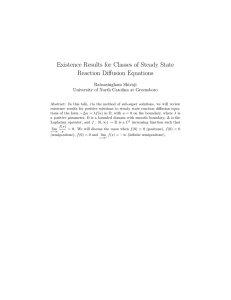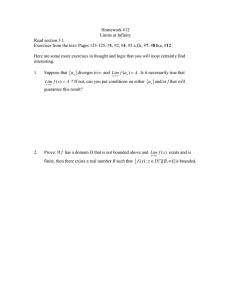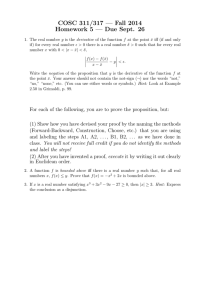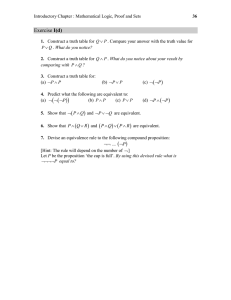Existence of Solution for Dirichlet Problem with p(x)
advertisement
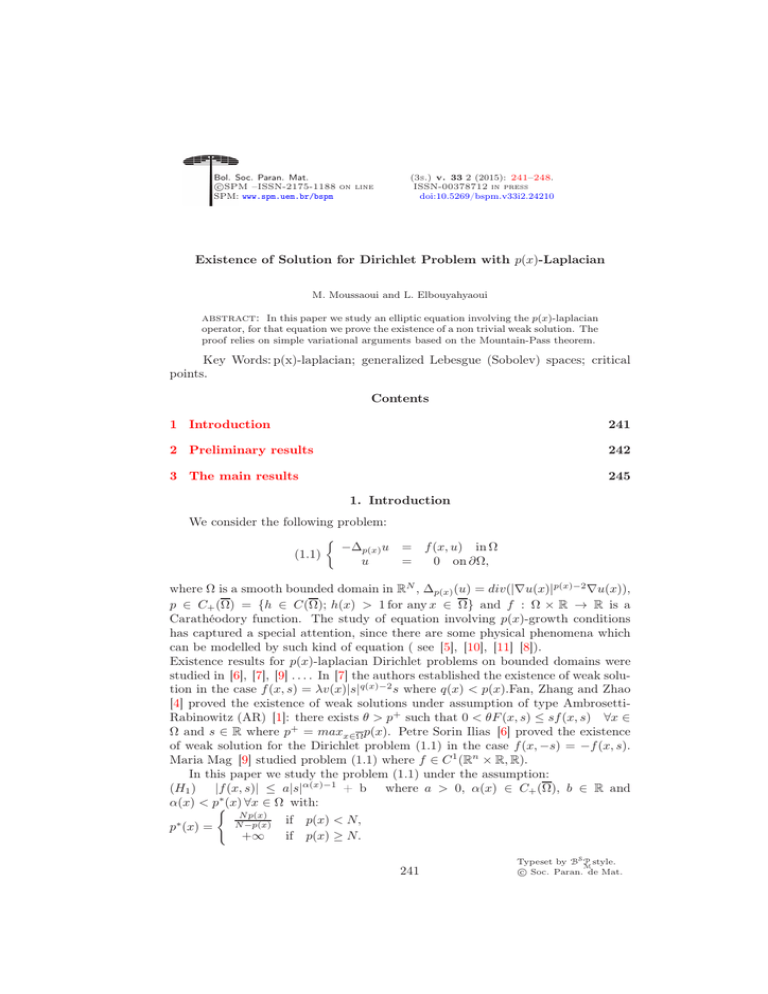
Bol. Soc. Paran. Mat.
c
SPM
–ISSN-2175-1188 on line
SPM: www.spm.uem.br/bspm
(3s.) v. 33 2 (2015): 241–248.
ISSN-00378712 in press
doi:10.5269/bspm.v33i2.24210
Existence of Solution for Dirichlet Problem with p(x)-Laplacian
M. Moussaoui and L. Elbouyahyaoui
abstract: In this paper we study an elliptic equation involving the p(x)-laplacian
operator, for that equation we prove the existence of a non trivial weak solution. The
proof relies on simple variational arguments based on the Mountain-Pass theorem.
Key Words: p(x)-laplacian; generalized Lebesgue (Sobolev) spaces; critical
points.
Contents
1 Introduction
241
2 Preliminary results
242
3 The main results
245
1. Introduction
We consider the following problem:
−∆p(x) u
(1.1)
u
= f (x, u) in Ω
=
0 on ∂Ω,
where Ω is a smooth bounded domain in RN , ∆p(x) (u) = div(|∇u(x)|p(x)−2 ∇u(x)),
p ∈ C+ (Ω) = {h ∈ C(Ω); h(x) > 1 for any x ∈ Ω} and f : Ω × R → R is a
Carathéodory function. The study of equation involving p(x)-growth conditions
has captured a special attention, since there are some physical phenomena which
can be modelled by such kind of equation ( see [5], [10], [11] [8]).
Existence results for p(x)-laplacian Dirichlet problems on bounded domains were
studied in [6], [7], [9] . . . . In [7] the authors established the existence of weak solution in the case f (x, s) = λv(x)|s|q(x)−2 s where q(x) < p(x).Fan, Zhang and Zhao
[4] proved the existence of weak solutions under assumption of type AmbrosettiRabinowitz (AR) [1]: there exists θ > p+ such that 0 < θF (x, s) ≤ sf (x, s) ∀x ∈
Ω and s ∈ R where p+ = maxx∈Ω p(x). Petre Sorin Ilias [6] proved the existence
of weak solution for the Dirichlet problem (1.1) in the case f (x, −s) = −f (x, s).
Maria Mag [9] studied problem (1.1) where f ∈ C 1 (Rn × R, R).
In this paper we study the problem (1.1) under the assumption:
(H1 ) |f (x, s)| ≤ a|s|α(x)−1 + b where a > 0, α(x) ∈ C+ (Ω), b ∈ R and
∗
α(x) < p(
(x) ∀x ∈ Ω with:
N p(x)
if p(x) < N,
N −p(x)
p∗ (x) =
+∞
if p(x) ≥ N.
241
Typeset by BSP
style.
M
c Soc. Paran. de Mat.
242
M. Moussaoui and L. Elbouyahyaoui
η
(H2 ) F (x, s) − sf (x, s) ≥ B(x) − β|s|
where B(.) ∈ L1 (Ω), η, β ∈ R and η < p−
−
where p = minx∈Ω p(x)
+
(H3 ) f (x, s) = o(|s|P −1 ) as s → 0 and uniformly for x ∈ Ω .
and
(H4 ) F (x, s) ≥ γ|s|θ − b1 |s|r + B1 (x) in a subset Ω1 ⊂ Ω, with |Ω1 | > 0,
γ > 0, s ∈ R, r ≥ 0, θ > sup(p+ ; r), B1 (.) ∈ L1 (Ω) and b1 ∈ R.
Remark 1.1.
1. It is known that (H4 ) is weaker than the condition (AR),
moreover we assume the condition on measuring portion of the set Ω.
2. Similar result can be obtained, if we replace in (H4 ) the assumption s ∈ R by
s ∈ R+ ( or s ∈ R− ).
This paper is divided into three sections. In the second section, we introduce
some basic properties of the generalized Lebesgue-Sobolev spaces and several important properties of p(x)-Laplace operator. In the third section, we give some
existence results of weak solutions of problem (1.1).
2. Preliminary results
In this section we recall some results on variable exponent Sobolev space, the
reader is referred to [2], [6], [3] and the references therein for more details.
Set
M = {u : Ω → R; u isR a measurable real- valued function}.
Lp(x) (Ω) = {u ∈ M ; Ω |u(x)|p(x) dx < +∞}.
We define on Lp(x) the so- called Luxemburg norm by the formula:
Z
u(x) p(x)
|
|u|p(x) = inf{µ > 0;
|
dx ≤ 1}.
µ
Ω
Variable exponent Lebesgue spaces (Lp(x) (Ω), |.|p(x) ) resemble to classical Lebesgue
spaces in many respects; they are reflexive and Banach space.
On Lp(x) (Ω) we also consider the function ϕp(x) : Lp(x) (Ω) → R defined by:
ϕp(x) (u) =
Z
|u|p(x) dx.
Ω
Proposition 2.1. ( [3])
1. We have the equivalence:
|u|p(x) < (>, =)1 ⇔ ϕp(x) (u) < (>, =)1.
−
+
+
−
2. |u|p(x) > 1 =⇒ |u|pp(x) ≤ ϕp(x) (u) ≤ |u|pp(x) .
3. |u|p(x) < 1 =⇒ |u|pp(x) ≤ ϕp(x) (u) ≤ |u|pp(x) .
Existence of Solution for Dirichlet Problem with p(x)-Laplacian
243
4. A ⊆ Lp(x) (Ω) is bounded if and only if ϕp(x) (A) ⊆ R is bounded.
5. For a sequence (un ) ⊂ Lp(x) (Ω) and an element u ∈ Lp(x) (Ω), the following
statements are equivalent:
•
•
lim un = u in Lp(x) (Ω).
n→+∞
lim ϕp(x) (un − u) = 0.
n→+∞
• un → u in measure in Ω and
6.
lim |un |p(x) = +∞ if and only if
n→+∞
lim ϕp(x) (un ) = ϕp(x) (u).
n→+∞
lim ϕp(x) (un ) = +∞.
n→+∞
We define the variable Sobolev space
∂u
1,p(x)
p(x)
p(x)
W
(Ω) = u ∈ L
(Ω);
∈L
(Ω) for all 1 ≤ i ≤ N
∂xi
and equipp it with the norm
||u||1,p(x) = |u|p(x) + |∇u|p(x) ,
1,p(x)
denote by W0
(Ω) as the closure of C0∞ (Ω) in W 1,p(x) (Ω).
Proposition 2.2. (see [2])
1,p(x)
1. W 1,p(x) (Ω) and W0
(Ω) are separable reflexive Banach spaces.
2. If q ∈ C+ (Ω) and q(x) < p∗ (x) for any x ∈ Ω, then the embedding from
W 1,p(x) (Ω) to Lq(x) (Ω) is compact and continuous.
3. There is a constant C > 0, such that
|u|p(x) ≤ C|∇u|p(x)
1,p(x)
∀u ∈ W0
(Ω).
By the assertion 3 of Proposition 2.2, we know that |∇u|p(x) and ||u||1,p(x) are
1,p(x)
equivalent norms on W0
(Ω).
1,p(x)
(Ω) equipped with the norm
Let E denote the generalized Sobolev space W0
||u|| = |∇u|p(x) , the p(x)-laplacian operator is defined by:
−∆p(x) : E −→ E ∗
Z
|∇u|p(x)−2 ∇u∇v dx;
< −∆p(x) u, v >=
Ω
Proposition 2.3. (see [4])
u, v ∈ E.
244
M. Moussaoui and L. Elbouyahyaoui
1. −∆p(x) : E −→ E ∗ is a homeomorphisme from E into E ∗ .
2. −∆p(x) : E −→ E ∗ is a strictly monotone operator, that is
< −∆p(x) u − (−∆p(x) )v, u − v > > 0,
∀u 6= v
3. −∆p(x) : E −→ E ∗ is a mapping of type S+ , that is, if un ⇀ u in E and
lim sup < −∆p(x) un − (−∆p(x) )u, un − u >≤ 0 then un −→ u in E
n→+∞
Proposition 2.4. ( [4]) The functional H : E −→ R defined by:
Z
1
|∇u|p(x) dx
H(u) =
p(x)
Ω
is continuously Fréchet differentiable and H ′ (u) = −∆p(x) u, for all u ∈ E.
In the last part of this section we recall the basic results of the Nemytskii
operator.
Let f : Ω×R → R a Carathéodory function and u ∈ M , the function Nf (u) : Ω → R
defined by Nf (u)(x) = f (x, u(x)) is mesurable in Ω, thus the Carathéodory function
f defines an operator Nf : M → M , which is called the Nemytskii operator.
Proposition 2.5. ( [12]) Suppose f : Ω × R → R is a Carathéodory function and
satisfies the growth condition
α(x)
|f (x, t)| ≤ c|t| β(x) + h(x), for any x ∈ Ω, t ∈ R,
where α(.), β(.) ∈ C+ (Ω̄), c ≥ 0 is constant and h ∈ Lβ(x) (Ω). Then Nf (Lα(x) (Ω)) ⊂
Lβ(x) (Ω). Moreover, Nf is continuous from Lα(x) (Ω) to Lβ(x) (Ω) and maps bounded
set into bounded set.
For a function α(.) ∈ C+ (Ω), we recall that β(.) ∈ C+ (Ω) is its conjugate
1
1
function if α(x)
+ β(x)
= 1 for all x ∈ Ω.
Proposition 2.6. ( [6], [3]) Suppose f : Ω × R −→ R is a Carathéodory function
and satisfies the growth condition
|f (x, t)| ≤ c|t|α(x)−1 + h(x), for any x ∈ Ω, t ∈ R
where c ≥ 0 is constant, α ∈ C+ (Ω), h ∈ Lβ(x) (Ω) and β ∈ C+ (Ω) is the conjugate
function of α.
Rt
Let F : Ω × R −→ R, defined by F (x, t) = 0 f (x, s)ds, then:
1. F is a Carathéodory function and there exist a constant c1 ≥ 0 and σ ∈ L1 (Ω)
such that:
|F (x, t)| ≤ c1 |t|α(x) + σ(x); x ∈ Ω, t ∈ R.
R
¯
2. The functional J¯ : Lα(x) (Ω) −→ R defined by J(u)
= Ω F (x, u(x))dx is
R
′
continuously Fréchet differentiable and < J¯ (u), v >= Ω f (x, u(x))v(x) dx
for all u, v ∈ Lα(x) (Ω).
Existence of Solution for Dirichlet Problem with p(x)-Laplacian
245
Lemma 2.7. Suppose f : Ω × R −→ R is a Carathéodory function and satisfies the
growth condition Ras in proposition 2.6 above and α(x) < p∗ (x), then N̄f : E −→ E ∗ ,
where N̄f (u)v = Ω f (x, u(x))v(x)dx is strongly continuous.
Proof: The embedding E ֒→ Lα(x) (Ω) is compact, hence the diagram
I∗
Nf
I
E ֒→ Lα(x) (Ω) −→ Lβ(x) (Ω) ֒→ E ∗
shows that N̄f : E −→ E ∗ is strongly continuous.
✷
3. The main results
Let the functional Φ defined by:
Φ:
Φ(u) =
Z
Ω
E −→ R
Z
1
F (x, u(x)) dx.
|∇u|p(x) dx −
p(x)
Ω
Under assymption (H1 ), the result from proposition 2.4 and proposition 2.6,
show that Φ is a C 1 functional on E and
′
Φ (u) = −∆p(x) u − N̄f (u),
∀u ∈ E.
′
It is obvious that u ∈ E is a weak solution for problem (1.1) if and only if Φ (u) = 0.
For that we will apply a mountain pass type argument to find nonzero critical point
of Φ.
Our main result is given by the following theorem.
Theorem 3.1. Assume (H1 ), (H2 ), (H3 ) and (H4 ) hold, then the problem (1.1)
has a non trivial weak solution.
Definition 3.2. We say that a C 1 functional I : E −→ R satisfies the PalaisSmale condition (P S) if any sequence (un ) ⊂ E such that (I(un )) is bounded and
′
I (un ) −→ 0 has a convergent subsequence.
Lemma 3.3. Assume (H1 ) and (H2 ) hold, then the functional Φ : E −→ R satisfies
the (PS) condition.
Proof: Let (un ) ⊂ E such that
′
|Φ(un )| ≤ d for some d ∈ R and Φ (un ) −→ 0.
(3.1)
We will show that (un )n∈N is bounded in E.
Arguing by contradiction and passing to a subsequence, we have ||un || → +∞.
Using (3.1) it follows that for n large enough, we have
|Φ′ (un )un − Φ(un )| ≤ d + ||un || (d ∈ R).
246
M. Moussaoui and L. Elbouyahyaoui
So, we obtain
Z
Z
|∇un |p(x) dx−
Ω
hence
Z
Ω
(1 −
1
|∇un |p(x) dx+
Ω p(x)
1
)|∇un |p(x) dx +
p(x)
Z
Z
F (x, un (x))−un f (x, un (x))dx ≤ d+||un ||,
Ω
F (x, un (x)) − un f (x, un (x))dx ≤ d + ||un ||.
Ω
The above inequalities combined with (H2 ) and proposition 2.1, yields:
Z
1
p−
η
(1 − − )||un || − B − β||un || ≤ d + ||un || (B =
b(x) dx ∈ R).
p
Ω
(3.2)
passing to the limit as n → +∞, taking account that, 1 < p− and η < p− , we
obtain a contradiction, so (un ) is bounded, hence, up to a subsequence we may
assume that un ⇀ u. R
¯ : J(u) =
F (x, u(x))dx, J ′ : E → E ∗ is completely continuous (see
Let J = J/E
Ω
[4]), since un ⇀ u, we have
J ′ (un ) → J ′ (u).
In other hand
Φ′ (un ) = −∆p(x) (un ) − J ′ (un ) → 0.
So
−∆p(x) (un ) → J ′ (u).
Since −∆p(x) is of type (S+ ), we deduce that un → u, and so Φ satisfies (PS)
condition.
✷
We will show that Φ satisfies conditions of Mountain Pass lemma.
Lemma 3.4. Assume (H1 ) and (H3 ), then there exist ρ > 0 and δ > 0 such that
Φ(u) ≥ δ > 0 for every u ∈ E and ||u|| = ρ.
+
Proof: From the embedding E ֒→ Lp (Ω), there exists C0 > 0 such that:
|u|p+ ≤ C0 ||u|| ∀u ∈ E.
+
Let ǫ > 0 be small enough such that ǫC0p ≤
The assumptions (H1 ) and (H3 ) gives:
+
1
2p+ .
F (x, s) ≤ ǫ|s|p + C(ǫ)|s|α(x)
∀(x, s) ∈ Ω × R.
Without loss of generality, we assume p+ < α− (via (H1 )), hence for ||u|| < 1 we
have:
Existence of Solution for Dirichlet Problem with p(x)-Laplacian
Φ(u)
≥
Z
Ω
1
|∇u|p(x) dx − ǫ
p+
Z
+
|u|p dx − C(ǫ)
Ω
+
+
+
1
≥
||u||p − ǫC0P ||u||p − kC(ǫ)||u||α−
+
p
+
1
||u||p − kC(ǫ)||u||α−
≥
2p+
+
+
1
≥ [ + − kC(ǫ)||u||α− −p ]||u||p .
2p
Z
247
|u|α(x) dx
Ω
(||u||α(x) ≤ k||u||)
So the proof is complete.
✷
Lemma 3.5. Assume (H1 ) and (H4 ), then, there exist e ∈ E such that ||e|| > 0
and Φ(e) < 0.
Proof: Let ϕ ∈ C0∞ (Ω) such that supp ϕ ⊂ Ω1 , and ||ϕ|| > 0.
For t > 1, we have:
Z
Z
1
p(x)
F (x, tϕ(x))dx
|∇tϕ|
dx −
Φ(tϕ) =
Ω
Ω p(x)
Z
Z
Z
′
′
′
+
1
|ϕ|r dx − C (C ∈ R).
|ϕ|θ dx + b tr
|∇ϕ|p(x) dx − γtθ
≤ tp
Ω1
Ω1
Ω p(x)
R
|ϕ|θ dx > 0 and γ > 0, the inequality above implies
Since sup(r, p+ ) < θ,
Ω1
Φ(tϕ) → −∞ as t → +∞, hence the proof is complete.
✷
Proof of theorem 3.1. To prove theorem 3.1, we will apply the Mountain
Pass theorem of Ambrosetti- Rabinowitz, taking e as given in lemma 3.5, and ρ as
follow in lemma 3.4.
References
1. A.Ambrosetti and P.H.Rabinowitz, Dual variational methods in critical point theory, J. Func.
Anal. 14(1973), 349-381.
2. X. Fan, J.Shen and D.Zhao, Sobolev Embedding Theorems for Spaces W k,p(x) (Ω), J. Math.
Anal. Appl. 262(2001),749-760.
3. X. Fan and D. Zhao, on the spaces Lp(x) (Ω) and W m,p(x) (Ω). J.Math. Anal. Appl. 263(2001),
424-446.
4. X. L.Fan and Q.H.Zhang, Existence of solution for p(x)-Laplacian Dirichlet problem. Nonlinear Anal. 52(2003), 1843-1852.
5. T. C. Halsey, Electrorheologicalfluids, Science 258(1992), 761-766.
6. P. S. Ilyas, Dirichlet problem with p(x)-Laplacian. AMS.Math.Reports 10(60),1(2008), pp
43-56.
7. K. Kefi, p(x)-Laplacian with indefinite weight. AMS. V 139, N 12 (2011),pp 4351-4360.
248
M. Moussaoui and L. Elbouyahyaoui
8. M. Mihailescu and V. Radulescu, A multiplicity result for a nonlinear degenerate problem arising in the theory of electrorheological fluids, Proc. Roy. Soc. London Ser. A 462(2006),26252641.
9. M. Magdalena Boureanu, Existence of solution for an elliptic equation involving the p(x)Lplace operator. E,J,D,E, Vol 2006(2006), N. 97, pp. 1-10.
10. M. Ruzicka, Eletrorheological Fluids: Modeling and Mathematical Theory, Springer-Verlag,
Berlin, 2002.
11. V. Zhikov, Averaging of functionals in the calculus of variations and elasticity, Math. USSR.
Izv. 29(1987), 33-66.
12. D. Zhao and X.L. Fan, On the Nemytskii operators from Lp1 (x) (Ω) to Lp2 (x) (Ω). J. Lanzhou
Univ. 34(1998),1-5.
M. Moussaoui
CRMEF (Centre Régionale des Métiers d’Education et de Formation), Taza, Maroc.
E-mail address: mmoussaoui_2@yahoo.fr

